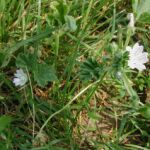| Common Name: |
Cheeseflower |
| Other Names: |
Blue Mallow, Common Mallow, Country Mallow, High Mallow, Mallow |
| Botanical Name: |
Malva sylvestris |
| Genus: |
Malva |
| Family: |
Malvaceae |
| Native Location: |
Europe, N Africa, and SW Asia |
| Cultivation: |
Well-drained to poor soil, in sun or partial shade. Prone to rust. |
| Propagation: |
By seed sown in early spring or summer; by basal cuttings in spring. |
| Harvest: |
Leaves and flowers are gathered in summer and used fresh for compresses or dried for infusions and liquid extracts. Fruits (seed capsules) are picked when green and used fresh. |
| Variations: |
Brave Heart
Has purple-pink, strongly veined flowers, to 8cm (3in) across.
Height: 90cm (36in) |
Cottenham Blue
Is early flowering, with pale mauve-blue flowers
Height: 70cm (30in) |
Primley Blue
Is prostrate, with pale-blue mauve flowers.
20cm (8in)
30-60cm (12-24in). |
|
| Height: |
45-90cm (18-36in) |
| Width: |
60cm (24in) |
| Hardiness: |
Z4-9 |
| History: |
Often confused with marshmallow, with which it shares similar therapeutic properties, mallow has been used as a medicinal herb and as a vegetable since at least ancient Roman times. The leaves, flowers and fruits are all edible and rich in vitamins A, B, and C. The plant's high mucilage content—which is responsible for the herb's soothing properties—inspired its common name, a derivation of the Old English word malwe, for "soft". Mallow was a popular healing herb through the 1500s and was once believed to be an herbal cure-all. Its popularity diminished, however, with the increased use of marshmallow, whose similar healing effects are more potent than mallow's. Today, mallow is often used as a substitute for marshmallow but enjoys greater popularity as an ornamental plant, famed for its wide variety of beautiful flowers. |
| Parts Used: |
Leaves, flowers, fruits. |
| Properties: |
A mucilaginous, slightly astringent herb that is expectorant, soothes irritated tissues, and reduces inflammation. |
| Medicinal Uses: |
Internally for throat infections, mucus, bronchitis, coughs, asthma, emphysema, and gastritis. Combines well with Eucalyptus globulus (See, Eucalyptus) for bronchial infections. Large doses are laxative. Externally for weeping eczema, boils, abscesses, and insect bites.
Mallow has anti-inflammatory, astringent, demulcent, and expectorant properties. It soothes inflamed and irritated mucous membranes of the intestines, mouth, respiratory tract, stomach, and throat. Mallow is taken internally for bronchitis, coughs, emphysema, gastritis, laryngitis, and tosillitis. It is applied externally, in poultices, to treat minor burns and other skin irritations. |
| Preparation: |
Mallow tea is most potent when made with cold water then drunk lukewarm. To make a tea, add 1 teaspoon of dried herb or 2 teaspoons of fresh herb to 1 cup of cold water, stir and let stand for at least 8 hours. Strain, and warm tea slightly over low heat or by adding 1 tablespoon of boiled water to the mixture (Do not steep herb in boiling water). Drink up to 1 cup a day. |
| Culinary Uses: |
Young leaves and shoots are eaten raw in salads or cooked in vegetable dishes. Unripe seed capsules, known as "cheeses" because of their shape, make an unusual addition to salads. |
| Bibliography: |
Encyclopedia of Herbs by Deni Brown Copyright © 1995, 2001 Dorling Kindersley Limited Pp 270-271
The Modern Herbal Primer by Nancy Burke Copyright©2000 Yankee Publishing, Inc. pp. 77-78 |
